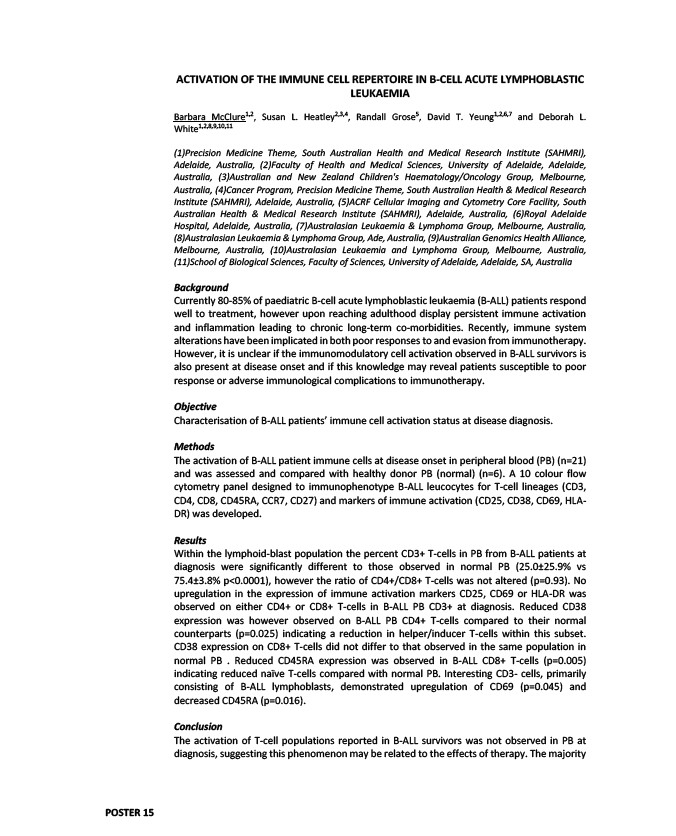
ACTIVATION OF THE IMMUNE CELL REPERTOIRE IN B-CELL ACUTE LYMPHOBLASTIC
LEUKAEMIA
Barbara McClure1,2, Susan L. Heatley2,3,4, Randall Grose5, David T. Yeung1,2,6,7 and Deborah L.
White1,2,8,9,10,11
(1)Precision Medicine Theme, South Australian Health and Medical Research Institute (SAHMRI),
Adelaide, Australia, (2)Faculty of Health and Medical Sciences, University of Adelaide, Adelaide,
Australia, (3)Australian and New Zealand Children's Haematology/Oncology Group, Melbourne,
Australia, (4)Cancer Program, Precision Medicine Theme, South Australian Health & Medical Research
Institute (SAHMRI), Adelaide, Australia, (5)ACRF Cellular Imaging and Cytometry Core Facility, South
Australian Health & Medical Research Institute (SAHMRI), Adelaide, Australia, (6)Royal Adelaide
Hospital, Adelaide, Australia, (7)Australasian Leukaemia & Lymphoma Group, Melbourne, Australia,
(8)Australasian Leukaemia & Lymphoma Group, Ade, Australia, (9)Australian Genomics Health Alliance,
Melbourne, Australia, (10)Australasian Leukaemia and Lymphoma Group, Melbourne, Australia,
(11)School of Biological Sciences, Faculty of Sciences, University of Adelaide, Adelaide, SA, Australia
Background
Currently 80-85% of paediatric B-cell acute lymphoblastic leukaemia (B-ALL) patients respond
well to treatment, however upon reaching adulthood display persistent immune activation
and inflammation leading to chronic long-term co-morbidities. Recently, immune system
alterations have been implicated in both poor responses to and evasion from immunotherapy.
However, it is unclear if the immunomodulatory cell activation observed in B-ALL survivors is
also present at disease onset and if this knowledge may reveal patients susceptible to poor
response or adverse immunological complications to immunotherapy.
Objective
Characterisation of B-ALL patients’ immune cell activation status at disease diagnosis.
Methods
The activation of B-ALL patient immune cells at disease onset in peripheral blood (PB) (n=21)
and was assessed and compared with healthy donor PB (normal) (n=6). A 10 colour flow
cytometry panel designed to immunophenotype B-ALL leucocytes for T-cell lineages (CD3,
CD4, CD8, CD45RA, CCR7, CD27) and markers of immune activation (CD25, CD38, CD69, HLA-DR)
was developed.
Results
Within the lymphoid-blast population the percent CD3+ T-cells in PB from B-ALL patients at
diagnosis were significantly different to those observed in normal PB (25.0±25.9% vs
75.4±3.8% p<0.0001), however the ratio of CD4+/CD8+ T-cells was not altered (p=0.93). No
upregulation in the expression of immune activation markers CD25, CD69 or HLA-DR was
observed on either CD4+ or CD8+ T-cells in B-ALL PB CD3+ at diagnosis. Reduced CD38
expression was however observed on B-ALL PB CD4+ T-cells compared to their normal
counterparts (p=0.025) indicating a reduction in helper/inducer T-cells within this subset.
CD38 expression on CD8+ T-cells did not differ to that observed in the same population in
normal PB . Reduced CD45RA expression was observed in B-ALL CD8+ T-cells (p=0.005)
indicating reduced naïve T-cells compared with normal PB. Interesting CD3- cells, primarily
consisting of B-ALL lymphoblasts, demonstrated upregulation of CD69 (p=0.045) and
decreased CD45RA (p=0.016).
Conclusion
The activation of T-cell populations reported in B-ALL survivors was not observed in PB at
diagnosis, suggesting this phenomenon may be related to the effects of therapy. The majority
POSTER 15